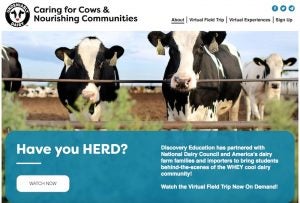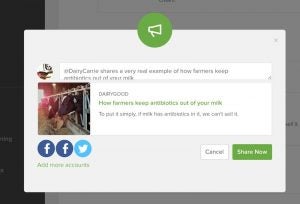“How do we educate consumers on farming?” I hear this from farmers at almost every communications training I conduct.
First, let’s get rid of the word “educate.” While people like to consider themselves educated, they don’t like to be educated. Instead you can give them useful and entertaining insights about farming.

They want to be insiders on how farming works and they want to know farmers (farmers are still one of the most respected industries in the nation — check out the latest Gallup Poll) so they can ask questions directly.
What do you think they would like to have insights on? Probably the questions you get when you are at a wedding or maybe even the grocery store.
How are cows milked? What do dairy cows eat? Where do they sleep? How long after the milk leaves the farm does it take to get to my house? Are dairy cows treated well?
You can answer these types of questions easily. But when using Facebook, instead of just answering these questions, think of how you can show them the answer by telling them a story.
Here’s a top 10 list of things to post on your Facebook farm page:

1. Post videos of farm life
Video and going Facebook Live on the farm is one of the best ways to be seen on social media. My suggestion is if you want people to listen to your message, then video the cows and calves doing their thing. People love the animals.
Top Tip: Use Video Show or Video Shop to edit your videos and add text to the video. Seventy percent of all video is viewed with the sound off. Here are my top 9 tips for recording video on your phone.

2. Post photos of farm life
If you can’t do video, then it’s always good to have a photo or a series of photos with your post. It helps for visibility in other’s Facebook feed and gives people an idea of how a modern farm looks today.
Top Tip: Add your farm logo or name to your photo before posting. While you always own the copyright, it lets your farm brand travel with the photo as people share it. Phonto, Canva, or Wordswag are my favorite apps for adding logos/text.

3. Answer questions without them asking
People are asking lots of questions about dairy farming on Google right now and you can find out what those questions are just by typing into the Google search bar and watching the Autocompletes. These are the top searches in my region — what are yours?

4. Get fans to engage and participate
You can ask people to help name calves, give them insight into how modern farm equipment works, or just let them know what happened today on the farm. For urban consumers, the farm is a big mystery or an exotic location and you can help them understand it better.

5. Give farm tours virtually
We worked with Discovery Education to do a virtual farm tour but you can give your own or work with your local checkoff to do one. This takes time but the engagement will be high — people love it and they will learn a lot.
6. Ask them what they want to know.
Sometimes all you have to do is ask and people will let you know what they want to know. Now, you will always have people who will be distractors. The main thing here is to engage when people really want to know vs. people just trying to get you to fight. If that happens, you can check out this post on arguments and what to do.

7. Share the best photos, videos, status updates from other farm pages.
Consider helping out other farmer and ag pages by sharing (which is the strongest way to help) and commenting (the second-strongest way to help) so they can reach more people on Facebook as well as keep the post higher up in people’s feeds. Liking other posts does very little in Facebook’s algorithm.

8. Try to be active at least once a day
If you can’t post something original, then consider sharing the content from your regional/local checkoff, another farmer page, or share content directly from our Dairy Hub Amplification Center. This web application can be connected directly to your Facebook page or other social media and allows you to share national/regional positive dairy stories that we verify. If you are a dairy farmer or someone in the dairy industry, you can join for free through this form.
9. When you share on your page, make sure to share on your profile as well.
Facebook gives more power to your personal profile page than your farm business page. So if you want your friends and family to see your post and hopefully share it with their friends, don’t forget to share it to your own page, too.

10. Use Facebook Advertising
Facebook’s boosted posts are a powerful way to reach consumers that are outside of your immediate area. You can select the audience you want to reach (women 22-60, closest urban area) for a relatively low cost depending on the number of followers you have (for around $5 you can reach about 1,000 people). I’ve found that boosting posts early can help get more people to see it.
BONUS TIP — Do your best to watch for trends that occur in the news and tie your posts back to what’s happening in the news cycle. For example, as we get closer to winter people will talk about the cold and the holidays. You could address both topics in how you keep yourself and the animals protected from the elements. With the holidays, you could talk about which dairy products your family enjoys.
So what are your best practices for posting on your family farm page? I would love to add them here in the comments or you can send them to don.schindler@dairy.org or on any of my social media profiles.


